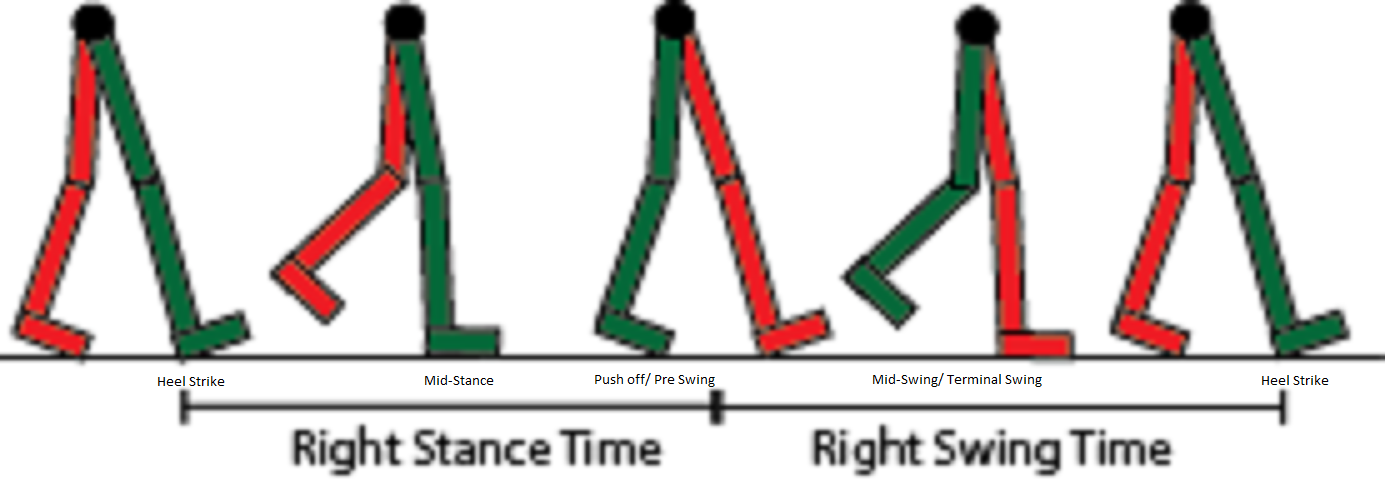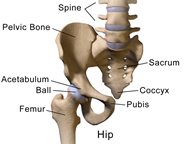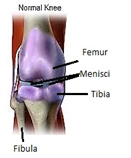|
Going back to gait this week, the earlier 2 posts on gait covered 1) the gait cycle and phases and 2) the role of the foot during gait. This week let us look at the role of the hip and knee joints and the rest of the lower limbs.
The lower extremities are made of the thigh which is the femur bone and lower leg which is a syndesmoses (immovable joint connected with connective tissue) of the tibia and fibula along with all the muscles and ligaments and the soft tissue which includes the blood vessels, nervous tissue, and fascia. The hip joint is formed by the head of femur with the cup shaped acetabulum formed by fusion of the three pelvic bones (namely the ilium, ischium and pubis). The acetabulum is deep and is further deepened by a cartilage called the acetabular rim. This gives the hip joint a great deal of stability as is needed by a weight bearing joint. The lower end of the femur is made up of two condyles (round protuberance of bones) which is received by the shallow concavity of the “tibial plateau.” This is the knee joint. Here again the articular or joint surface of the tibia (tibial plateau) is deepened by articular cartilages. These are the menisci - two in number and called the medial meniscus and lateral meniscus- based on their position. The menisci form the weight bearing surface of the knee joint. When we walk, there is simultaneous mobility and weight bearing at the knee joint, which makes it important for menisci to have some mobility so as not to get trapped within the joint during time of weight transfer or impact (running, jumping), since its major role is to deepen the sockets and provide cushioning effect or shock absorption and even distribution of the weight. Both the hip joint and knee joint function and stability are enhanced due to the presence of muscles and ligaments. The buttock is made of the 3 gluteii muscles (maximus, medius, and minimus). The hip flexors like iliacus, psoas, sartorius, and rectus femoris pass through the groin area. The major muscle that forms the bulk of the anterior thigh is the quadriceps. It ends in a tendon which crosses the knee joint in front and within which is embedded the knee cap or patella. The role of the knee cap is to increase the efficiency of the quadriceps. The main muscle at the back of the thigh is the Hamstrings. Both the quadriceps and hamstrings are made up of a group of muscles. The bulk of muscle in the calf or back of lower leg is Gastrocnemius and soleus. It inserts into the heel bone (calcaneum) of the foot and is responsible for the effective push-off. The front and sides of the lower leg consist of muscles that support the arches in the foot and produce necessary movement for weight transfer on foot. Now let us consider the gait cycle. During the stance phase, the hip is flexed at heel strike and gradually moves to neutral position as body weight moves over a stable foot, and ends in hip extension (actually 10 degrees of “hyperextension”- this comes from lumbar extension) just prior to push-off, at which point it begins flexion together with knee flexion. The maximal hip flexion (30 degrees) occurs during the swing phase to enable the foot to leave contact with the ground and “sail across” space so that the body translates forward and “covers ground.” The knee joint is in neutral or about 5 degrees of flexion at heel strike and it flexes slightly (15 degrees) in order to absorb the impact of initial contact with the ground and in preparation for weight bearing as the weight shifts to stance foot. This also brings stability by lowering the center of gravity of the body closer to the ground. The knee then gradually extends for joint stability at mid-stance for weight bearing and beginning of terminal stance when body progresses forward. At push-off (end of terminal stance), the knee flexes with the hip and attains about 60 degrees of flexion at peak swing, then begins relative extension towards heel strike. At heel strike, the anterior tibial muscles are contracting to keep the foot in dorsiflexion and as they do so, it pulls the proximal end of the tibia forward, bringing the knee into flexion for shock absorption. The hip is stabilized and thrust forward by a strong contraction of the gluteus maximus and adductor magnus. The quadriceps begin to extend the knee and as the body progresses forward over a stable foot, the gluteus maximus contracts as weight bearing occurs at mid- stance and continues into terminal stance phase, progressing the body forwards. The iliacus and hamstrings bring about hip and knee flexion respectively for the push-off phase and swing phase. The limb then goes into deceleration as it prepares to go into the subsequent heel strike and the cycle continues seamlessly.
0 Comments
Your comment will be posted after it is approved.
Leave a Reply. |
Details
AuthorAmi Gandhi is a licensed physical therapist in the state of California. She is the owner of StableMovement Physical Therapy, a small boutique practice in San Jose that offers patient centered, one-on-one, hands-on physical therapy. Archives
March 2018
Categories |


